High-frequency oscillatory ventilation on shaky ground
- PMID: 23339640
- PMCID: PMC4142426
- DOI: 10.1056/NEJMe1300103
High-frequency oscillatory ventilation on shaky ground
Figures

Comment on
-
High-frequency oscillation for acute respiratory distress syndrome.N Engl J Med. 2013 Feb 28;368(9):806-13. doi: 10.1056/NEJMoa1215716. Epub 2013 Jan 22. N Engl J Med. 2013. PMID: 23339638 Clinical Trial.
-
High-frequency oscillation in early acute respiratory distress syndrome.N Engl J Med. 2013 Feb 28;368(9):795-805. doi: 10.1056/NEJMoa1215554. Epub 2013 Jan 22. N Engl J Med. 2013. PMID: 23339639 Clinical Trial.
References
-
- Bohn DJ, Miyasaka K, Marchak BE, et al. Ventilation by high-frequency oscillation. J Appl Physiol. 1980;48:710–6. - PubMed
-
- Fredberg JJ. Augmented diffusion in the airways can support pulmonary gas exchange. J Appl Physiol. 1980;49:232–8. - PubMed
-
- Weinmann GG, Mitzner W, Permutt S. Physiological dead space during high-frequency ventilation in dogs. J Appl Physiol. 1984;57:881–7. - PubMed
-
- Slutsky AS, Drazen JM, Ingram RH, Jr, et al. Effective pulmonary ventilation with small-volume oscillations at high frequency. Science. 1980;209:609–71. - PubMed
-
- Rossing TH, Slutsky AS, Lehr JL, Drinker PA, Kamm R, Drazen JM. Tidal volume and frequency dependence of carbon dioxide elimination by high-frequency ventilation. N Engl J Med. 1981;305:1375–9. - PubMed
Publication types
MeSH terms
Grants and funding
LinkOut - more resources
Full Text Sources
Other Literature Sources
